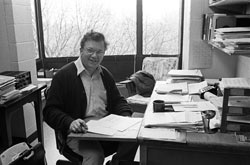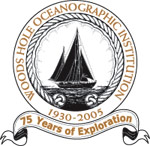This is an archived site. This site is no longer being maintained or reviewed for broken links.
Employee Portrait Gallery—Nick Fofonoff
 |
|
|
Nick Fofonoff was captured on film in his Clark Lab office in 1979. (Photo by Rob Brown)
|
Nick Fofonoff was born into a Russian-speaking farm home in Alberta, Canada, in 1929. This language background served him well decades later when he was a member of the organizing committee for the 1975–1981 Russian/American POLYMODE experiment mounted to study mid-ocean currents. It was one of many oceanographic organizing and managing positions he held—including being the only person to serve twice as chair of the WHOI Physical Oceanography Department (1967–1971 and 1981–1985). Senior Scientist Ray Schmitt and colleagues wrote in a 2005 biographical tribute to Nick for the Journal of Marine Research, “Anyone who worked under him came to appreciate his gentle style and universal accessibility.” He was, they said, a “thoughtful, wise and patient man.”
Nick’s higher education at the University of British Columbia was diverted from nuclear physics to ocean science when the university opened its Institute of Oceanography while he was a student there. He completed a bachelor’s degree in 1950 and a master’s degree in physics and mathematics in 1952 and then moved to Brown University for graduate work. Summer fellowships first introduced him to WHOI, and, while working for the Fisheries Research Board of Canada, he participated in the summer Geophysical Fluid Dynamics program here in 1961. He was appointed to the scientific staff the following year.
Interested in the physical properties of seawater and the dynamics of ocean currents, he was drawn by the WHOI Buoy Group’s mooring development work and soon became head of that operation. The early mooring efforts were characterized by hard work and frequent disappointment, but Nick and the group, at one time numbering as many as 40 people, persisted. Their eventual success with long-term instrumented moorings in the deep sea led to such large-scale programs as POLYMODE and the Institution’s wide reputation for mooring expertise. At the same time, Nick continued his studies of the properties of seawater and the thermodynamics of the ocean. His biographers noted that he loved technology and was the first to write software for translating CTD data into engineering units that allowed researchers to plot and manipulate it at sea. In addition, “He was a ham radio enthusiast and helped set up a communications system for the Falmouth Road Race before the days of cell phones.”
Nick retired in 1991 but continued his research, returning to an early interest in the thermodynamics of seawater. The University of Victoria awarded him an honorary degree in 2002. He died in December 2003, leaving a substantial scientific legacy, including, his colleagues wrote, “essential procedures that are used daily by oceanographers all over world.”
[back]

